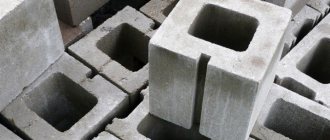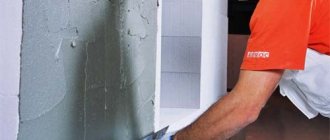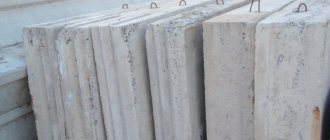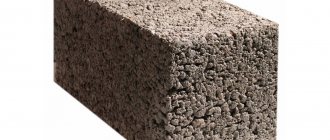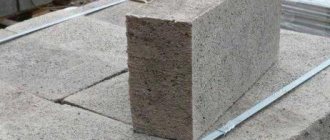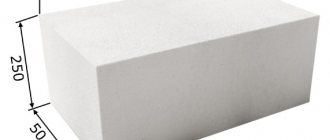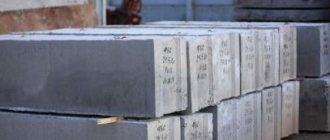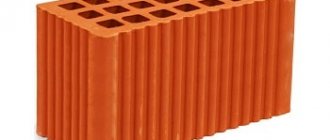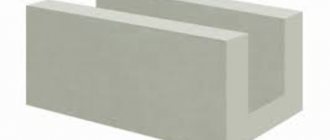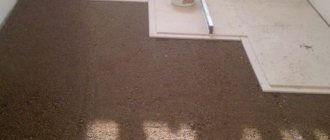Weight of expanded clay of different fractions in 1 m3, characteristics, prices
Expanded clay refers to a lightweight, free-flowing building material made from baked clay or shale in the form of sand, cubic crushed stone, round or oval gravel. The size of the fractions varies from 0 to 40 mm, the specific gravity depends on the brand and varies from 250 to 1000 kg/m3. It is used as bulk insulation, lightweight concrete filler, decorative bedding or layer in drainage systems. Expanded clay is most often sold in cubic meters; when calculating the loads of building structures or the amount of material purchased, it is important to know how much one cube weighs.
Specific gravity of different fractions
This indicator characterizes the ratio of the mass of granules in a dry state to the volume they occupy; due to the porosity and irregular shape of the particles, it is always several times less than the true density. Technical requirements for expanded clay are regulated by GOST 9757-90, this standard distinguishes grades of gravel and crushed stone from 250 to 600 kg/m3 (by agreement between the customer and the manufacturer, the production of grades M700 and M800 for mixing heavy expanded clay concrete is allowed) and sand and sand-gravel mixtures from 500 up to 1000. In the first case, the size of the fractions varies from 5 to 40 mm, in the second - 0-10. For calculations, the following values of the volumetric bulk density of expanded clay granules are used:
| Filler type | Fraction size, mm | Volumetric weight, kg/m3 |
| Expanded clay sand | 0-5 | 600 |
| Round granules or crushed stone | 5-10 | 450 |
| 10-20 | 400 | |
| 29-40 | 350 | |
| Unsorted expanded clay | — | 450 |
Non-standard fraction sizes include mixtures of gravel or crushed stone from 2.5 to 10 mm and from 5 to 40 and sand-gravel from 0 to 10 mm. By default, the mass of 1 cube of such brands is assumed to be 450 kg. Unlike other types of fillers, the high specific gravity of expanded clay is not an indicator of its quality; rather, on the contrary: the larger it is, the lower the porosity of the granules and the worse their thermal insulation abilities. But it all depends on the purpose, each brand is used for a specific purpose, so, to create structural blocks, denser types are purchased, for filling material as insulation, the lightest, and, accordingly, large ones are purchased. The last condition is important to take into account both in terms of increasing the temperature resistance of building structures and in order to reduce weight loads.
You can learn about the weight characteristics of sand from this article.
Theoretically, the smaller the granules, the more 1 cubic meter of expanded clay weighs. But the possibility of changes in internal porosity due to deviations in firing temperature or other conditions should be taken into account. In practice, the only way to obtain the exact bulk weight of expanded clay is to weigh 1 cube. The last factor influencing the value of the indicator is humidity, but it is usually neglected. Burnt clay granules are considered relatively resistant to getting wet, water absorption varies within 8-20%, no more, the rate of moisture removal is not inferior to its absorption.
Basic prices are shown in the table below. Each brand has its own purpose:
- Expanded clay sand (0-5 mm) or fine gravel (5-10 mm) is used for making mortars for screeds and building blocks, draining waterlogged soils.
- Expanded clay fraction 10-20 is recommended to be purchased for thermal insulation of floors and ceilings.
- Large granules (20-40) are used to insulate water mains. One cubic meter of the most common brand M450 in this range weighs no more than 350 kg; it is well suited for insulating roofing systems and basements.
| Delivery format | Fraction size, mm | Delivery volume, m3 | Price, rubles | |
| Wholesale (from 5 cubic meters and above) | Retail | |||
| In bags | 0-5 | 0,04 | 125 | 130 |
| 5-10 | 105 | 110 | ||
| 10-20 | 0,05 | 80 | 85 | |
| 20-40 | ||||
| in bulk | 0-5 | 1 cube | 3000 | 3050 |
| 5-10 | 2150 | 2200 | ||
| 10-20 | 1350 | 1320 | ||
| 20-40 | 1330 | 1380 | ||
The cost of expanded clay is primarily influenced by the volume of supply: batches over 500 m3 are cheaper. The same applies to transportation services. In addition, the price depends on seasonality, method of shipment, cost of production and size of granules.
During delivery, the expanded clay is lightly compacted; the compaction coefficient agreed with the consumer is no more than 1.15. It is used when checking the volume of shipment of large quantities.
Composition of expanded clay concrete block
Expanded clay concrete is based on a mixture of expanded clay, cement, quartz sand and water. The usual proportions are 60%, 10% and 30% respectively. In some cases, the manufacturer adds special plasticizers (additives) that create the necessary characteristics of the material.
Thorough mixing of the expanded clay mixture is carried out using special installations that allow you to remove excess air and make the solution as uniform as possible. The optimal sizes of the expanded clay concrete fraction vary from 5 to 10 mm. With such dimensions of the material, it is possible to provide a wide range of products in size and load-bearing capacity.
Standard expanded clay used to make a block
Expanded clay weight
Characteristics of expanded clay
Let's consider the main characteristics of expanded clay.
Expanded clay has won its niche among popular building materials, thanks to a large number of advantages, such as lightness, as well as for its excellent sound and heat insulating characteristics.
But when you have to choose to buy expanded clay, you need to decide on the required brand of expanded clay, because... The weight of expanded clay depends on it.
Everyone knows that expanded clay is a very popular and environmentally friendly building material, which has numerous positive reviews. First of all, expanded clay is a very good thermal insulator, and like all building materials that are excellent thermal insulators, expanded clay is an excellent sound insulator, the porous structure of expanded clay ensures low weight, expanded clay is resistant to moisture and temperature changes.
Weight of expanded clay blocks by size and presence of voids (table)
The table below shows the standard relationship between the weight and dimensions of an expanded clay concrete block.
| Type | Weight, kg | Dimensions, mm |
| Double-hollow | 14,7 | 390×190×188 |
| Double-hollow | 17,5 | 390×190×188 |
| 7-slot | 12,2 | 390×190×188 |
| 7-slot | 16,8 | 390×190×188 |
| Septal | 5,1 | 390×90×188 |
| Septal | 9,7 | 390×90×188 |
| Septal | 5,1 | 390×80×188 |
| Septal | 8,4 | 390×80×188 |
| Private smooth | 7 | 390×188×140 390×196×140 |
| Private smooth | 10,9 | 390×188×140 390×196×140 |
| Pillar 4-hollow (gray) | 34,3 | 390×390×188 |
| Full-bodied | 16,9 | 390×190×188 |
| Full-bodied | 26 | 390×190×188 |
| Full-bodied | 9,9 | 250×188×120 |
| Full-bodied | 12,8 | 250×188×120 |
By the way, if you are interested in the characteristics of this type of building material, we recommend watching this video
Specific gravity of expanded clay concrete. Weight of expanded clay concrete blocks.
Expanded clay concrete consists of blocks of expanded clay and a binding admixture: cement, gypsum and resin, bonded together using high temperatures. During production, quartz can be added to expanded clay concrete to improve its strength. Such material perfectly resists resolution factors.
Expanded clay concrete is widely used for construction purposes, mainly due to its thermal insulation properties. In addition, it is lightweight, durable and environmentally friendly. It is often used to construct floors and improve the energy-saving qualities of walls.
Qualitative advantages of using expanded clay concrete:
- Less density and lightness
- Reducing the load on the foundation
- Reduced wall installation costs
- Mechanical strength
- Large volume, which speeds up construction work
- Warm and thin walls – heat loss is reduced by 75%
The advantageous advantage of this material is ease of transportation, and therefore lower costs and economic benefits in the construction of residential and industrial premises.
Weight of expanded clay concrete blocks.
When making blocks from expanded clay concrete, lightweight materials are used, which create a porous structure of the final product. The weight of an expanded clay concrete block varies depending on its size and the raw materials used in production. So, for example, with a block size of 200*200*400, its weight can vary from 6 to 29 kg.
There are several brands of expanded clay concrete. Let's consider their scope:
Calculation of the specific gravity of expanded clay concrete blocks.
A feature of expanded clay concrete is porosity, so it is more important to calculate the specific density, which varies depending on the material used to make the blocks. A detailed description of the limits of fluctuation of the expanded clay concrete parameter weight m3 is presented in the table.
From this article you will receive useful information about expanded clay concrete blocks and their weight. Find out the weight of the expanded clay concrete block 390x190x190. Find out how much a 20x20x40 expanded clay concrete block weighs, and whether there is a difference in size between these blocks. And also: what does the weight of a block depend on, learn to calculate important indicators of a block. And, in general, you will find out the weight of 1 piece of expanded clay block.
Weight of expanded clay concrete block
The weight of the material serves as the basis both at the design stage of the facility and directly during construction. For an expanded clay concrete block, this parameter is determined:
- design strength grade,
- the integrity of the manufacturer, who must strictly follow the established technology for manufacturing the material;
- properly selected raw materials.
The wrong choice of expanded clay concrete increases the risk of making the structure heavier. This violates the design calculations for the strength of the building and can lead to serious consequences. Underestimation of strength (as well as overestimation) is unacceptable.
Standard element with 4 voids
Calculation example
The dimensions and weight of the block are given: 390x280x188mm, 5 slots; 18 kg.
- Finding the volume of the entire block
0.39 x 0.28 x 0.188 = 0.02 m3.
- Finding the volume of voids (cracks)
Let’s assume that the length of one slot is 140 mm, the width is 25 mm, and the depth is 175 mm.
0.14 x 0.025 x 0.18 x 5 = 0.003 m3.
- Finding the volume of expanded clay concrete
0.02 – 0.003 = 0.017 m3.
- Finding the block density
18: 0.017 = 1059 kg per m3 (it is often said that this is the specific gravity of expanded clay concrete in kg per m3).
Therefore, the weight of expanded clay concrete in 1 m3 is 1000 - 2000 kg, compared to aerated blocks, 1 m3 of which will weigh from 500 kg. The volumetric weight of expanded clay concrete, for example, grade 200, will not exceed 1800 kg per m3.
We determine quality by weight
The quality of an expanded clay product directly depends on many factors (raw materials, technology) and an accurate determination of the characteristics of a particular block is possible only in laboratory conditions. In practice, it is possible to identify defective elements by weighing. The density of the material determines the strength of the product and can be calculated quickly and accurately.
To assess the quality of an expanded clay block, do the following:
- Conduct a visual inspection of the block for chips, stains and other visible defects.
- The geometric parameters of the product are measured.
- Knowing the height, length, width and weight, the density is calculated.
Next, it is enough to check the result obtained with the product passport or regulatory documentation for building materials. Deviations for a standard expanded clay concrete block SKTs should not exceed those specified in the technical specifications.
Double-hollow element on a pallet
Types of expanded clay concrete and its purpose
Before considering how much a cube of expanded clay concrete weighs and what its specific gravity is, it is necessary to understand for what purposes it can be used.
The material differs in purpose:
- Structural - used for the production of high-strength wall and road slabs.
- Thermal insulation - applied to load-bearing walls from the inside or outside to improve thermal insulation characteristics and the production of blocks used in low-rise construction.
- Structural thermal insulation - differs from standard thermal insulation in that it is laid during the construction of load-bearing structures.
Volumetric weight or overall size of blocks
This concept refers to the weight of blocks that occupy a certain volume, for example one cubic meter. Depending on the density of the concrete, the blocks have different weights, so one cube of thermal insulating concrete is much lighter than structural concrete. The blocks that are used for thermal insulation have the lowest volumetric weight - it varies in the range from 500 to 900 kg/m3. This type does not require high reliability and strength, and it does not create excessive load on load-bearing walls and partitions.
As for the structural type, its cube weighs from 1400 to 1900 kg/m3 . The indicators of structural and thermal insulation expanded clay concrete should vary from 900 to 1400 kg/m 3. Typically, in industrial construction, blocks with optimal weight are selected, which will not make the structure too heavy, but will still provide sufficient strength. For example, in panel houses today they most often use 800 kg/m3.
Separately, it is worth considering the structural appearance. It has the highest strength when compared with other types, while its bulk density is quite low. This is due to the fact that in construction this type is used to lighten the load-bearing structure. It is also worth mentioning about the compressive strength, which ranges from 200 to 400 kg/cm2. If necessary, structural expanded clay concrete is reinforced; for this, both conventional and stressed reinforcement are used. The second type can be used with grade M200 or higher. In some situations, it is necessary to increase elasticity and strength - for this, quartz sand is used, which is added when making the solution.
When choosing a suitable material for building a house, it is recommended to use more durable grades, since private houses are usually built on 2-3 floors. In any case, the optimal brand will be 900–1200 kg/m3.
Specific gravity
We have analyzed how much a cube of thermal insulation and construction expanded clay concrete weighs. Specific gravity is the ratio of the volume of solid particles to their mass; very often this parameter is confused with density. The calculation is carried out in a dry state of the material. There are a number of factors that significantly affect specific gravity, the most important of which is grain size.
In industrial construction there are three fractions of this filler:
- Sand - the size of its fractions is 0–5 mm.
- Gravel - divided into 3 types: 5–10, 10–20, 20–40 mm.
- Crushed fraction - its size is 5–40 or 0–10 mm.
Why do we consider specific and volumetric gravity? The fact is that the choice of faction will determine how much a cube of this material holds. According to the state standard 9757-90, a grade corresponding to the density is set. For example, brand M250 has a volumetric weight of 250 kg/m 3.
It will also be useful to know the formula that can be used to obtain the maximum mass of expanded clay concrete:
- gbs - max possible volumetric weight of dry expanded clay concrete, kg/m 3 ;
- gк and gм - volumetric weight of coarse and fine aggregate, kg/m 3 ;
- Vk and Vm - consumption of coarse and fine aggregate per 1 m 3 of solution, m 3;
- C is the consumption of binder per 1 m 3 of mixed expanded clay concrete, kg.
To calculate the mass of expanded clay concrete, it is necessary to take into account the mass of materials that are used to create the solution, shape and size. For example, you can take standard blocks 200x200x400 mm; they can weigh from 6 to 30 kg. Their volumetric mass will be about 300 kg per cubic meter.
